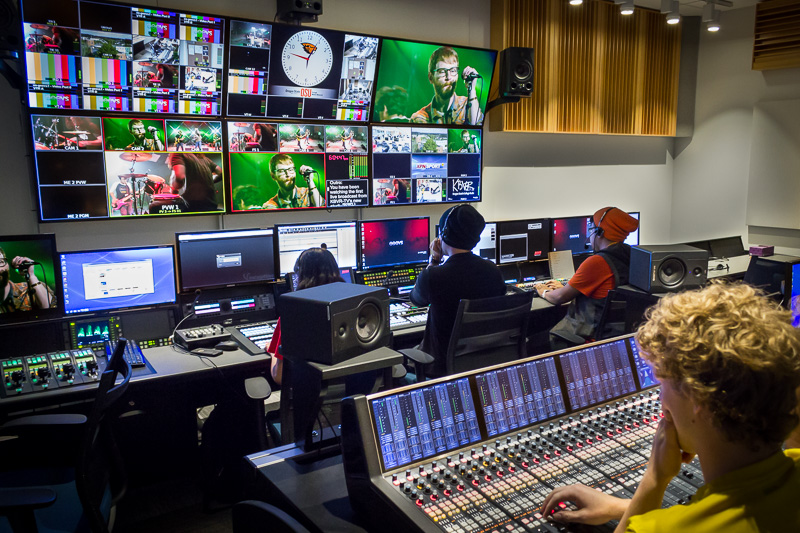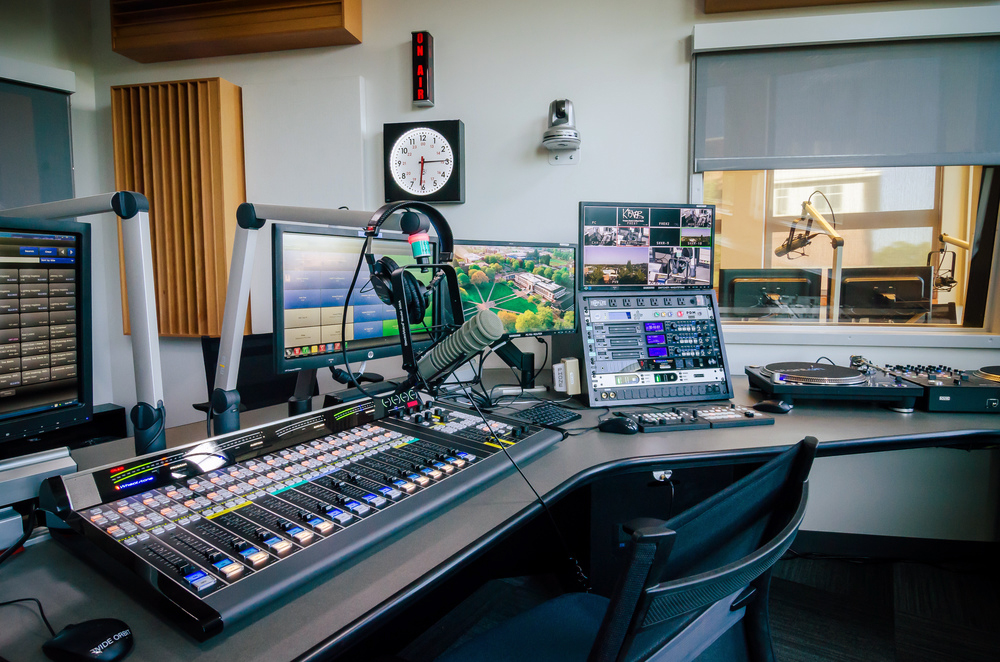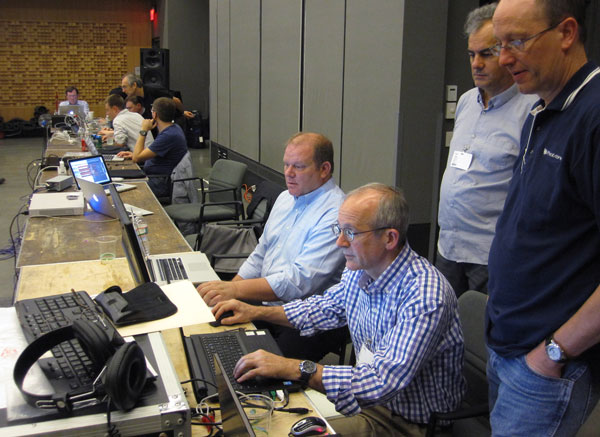WHEAT:NEWS TV Jan 2016 - Vol 3, No. 1
Got feedback or questions? Click my name below to send us an e-mail. You can also use the links below to follow us on popular social networking sites. The tabs at the very top of the page will take you to our web sites.
Integrating New Media with TV Production

By Erik Utter, Utter Associates
If you asked me which of the many projects I worked on last year showed the most promise as a model for integrating new media with TV, I’d have to choose the new $3.1 million, 14,000-square-foot media center at Oregon State University in Corvallis, Oregon.
It’s modern, it’s multifaceted and it’s an open, collaborative environment where students get hands-on experience producing content for the university’s KBVR-TV, KBVR-FM, the student newspaper, quarterly magazine, website and social media. KBVR-TV alone produces live newscasts as part of its 24/7 program lineup on a community public, educational and government access channel. In addition, KBVR-TV airs public affairs, variety and music shows, educational programming and sports. Plus, the station simulcasts online as a live Internet stream.
As the video engineering and consulting firm responsible for planning and design of the new facility, I was able to do some interesting things. For example, the six Grass Valley LDX HD studio cameras — one of which is on a crane — can be moved between studios or broken down and transported for live productions from around the campus utilizing existing fiber infrastructure. Similarly, the three M/E busses of the Ross Video Acuity production switcher can be shared between the new facility’s two production control rooms, each of which is equipped with an Acuity control surface. Grass Valley Kaleido multiviewers also can be shared and reconfigured on the fly to display every video source in the facility as needed.

Then there’s the Wheatstone WheatNet audio-over-IP network, which is the backend routing and control system for a Wheatstone Dimension Three console in the main newsroom and multiple LX-24 consoles in FM and ancillary production spaces. All I/O and control is managed through the WheatNet-IP audio network, making it possible to connect and change any channel to any source in the environment. This makes changes a lot easier, so the university can reuse studios for any purpose and instantly change and share microphone feeds, console mixes, and IFB connections. Students can completely reconfigure their resources depending upon whether the production is a newscast, a music production or a production in concert with the FM station.
Wheatstone’s new Dimension Three audio console combines easy IP access and I/O layering; students are able to profile channels into any configuration on the surface with unlimited access to sources at any time, from anywhere and in just about any format from the network. For a large format board, it had everything the university needed, yet was intuitively laid out so that the average student could get the hang of it easily.
For sports and other remote venues, the university also went with the L-8 audio console, another WheatNet-IP audio console that was sized just right for mixing in the field. We linked it to the studio network from the field using optical fiber.
Audio-over-IP was absolutely critical to having that ability to reconfigure feeds and control on a production-by-production basis.
WheatNet-IP also provides a common platform for resource sharing and routing of microphones, processors, servers and even the intercom. The RTS production intercom interfaces to WheatNet-IP over MADI links, allowing for complete intercom functionality from any control surface as well as simplified IFB and mix minus routing.
The system is really giving the university the flexibility it needs today, and as an AES67 compatible system, will give it the flexibility it needs in the future.
Erik Utter will be discussing audio networking and the multi-studio environment at the upcoming Seattle SBE Chapter 16 meeting on January 13.
Your IP Question Answered

Q: I’ve been told that WheatNet-IP is the audio network that has integrated control. What does that mean?
A: IP audio isn’t just about routing. It’s also about being able to control and automate audio. For example, WheatNet-IP has an integrated control layer that carries all the logic functions for audio. Control is built into each WheatNet-IP connection point that is shared with other IP connection points across the network, giving you access to not only all sources at once, but also the presets and any associated logic that goes along with each feed for controlling such things as mic ON/OFF, or changing remote mic settings for IFB, processing and other parameters. Being able to route audio in tandem with full system control makes a world of difference when it comes to handling the unexpected or repurposing a news set for multiple productions. Our Andy Calvanese explains this seamless integration of control, access and tools in the following video...

Wheatstone
- Great Eastern Radio (West Lebanon, NH) purchased a Network EDGE IP transport interface unit.
- On Air System of Mexico purchased six E-1 control surfaces and WheatNet-IP audio network BLADEs.
- Agile Broadcast (Victoria, Australia) purchased two E-1 control surfaces.
- Russia Today (Beijing, China) purchased an LX-24 control surface and WheatNet-IP BLADEs.
- C-Span (Washington, DC) purchased four L-8 control surfaces through The Systems Group.
- TBLC Holdings Ltd (Charlotte, NC) purchased an LX-24 control surface and WheatNet-IP audio network BLADE.
- Cox Media (Atlanta, GA) purchased a WheatNet-IP audio network with 44 BLADEs and accessories for the first phase of a WSB-AM studio rebuild.
- Reach Media (Dallas TX) purchased an LX-24 control surface with WheatNet-IP audio network BLADEs for the Tom Joyner show.
- iHeartMedia (Pittsburgh, PA) purchased an L-12 control surface for an additional production room.
- WGN-AM (Chicago, IL) purchased a TS-22 and TS-4 talent station and additional BLADEs for an existing WheatNet-IP audio network.
- Emmis’ KROX-FM (Austin, TX) purchased a TS-22 talent station and four TS-4 talent stations for an existing WheatNet-IP audio network.
- KILR-FM (Estherville, IA) purchased an IP-12 digital audio console.
- Zeera Group (Accra, Ghana) purchased three E-6 control surfaces.
- Zhejiang Radio (Hangzhou, China) purchased three LX-24 control surfaces and WheatNet-IP audio network through Audio Design Company.
- Hangzhou Radio (Hangzhou, China) purchased two LX-24 control surfaces and WheatNet-IP audio network through Audio Design Company.
- New-Press & Gazette’s KRDO-TV (Colorado Springs, CO) purchased an E-6 control surface with WheatNet-IP audio network.
- NFL Network (Los Angeles, CA) purchased a Gibraltar Cage and MADI cards to expand an existing Gibraltar Network.
Audioarts Engineering
- Radio Foshan (Foshan, China) purchased an Air-1 console through Audio Design Company.
- Jade Media (Kuala Lumpur, Malaysia) purchased an Air-4 console.
- Sun TV (Chennai, India) purchased an Audioarts 08 console through Horizon Broadcast.
- KRDR-FM (Red River, NM) purchased an R-55e console.
- KMOM-FM (Roscoe, SD) purchased an Air-1 console.
Wheatstone Audio Processing
- Great Eastern Radio (West Lebanon, NH) purchased an FM-55 audio processor and M1 mic processor.
- Broadcast World Philippines (Manila) purchased an AirAura, VP-8IP and FM-55 audio processor, plus a VoxPro 5 digital audio editor.
- Broadcast Electronics purchased an FM-55 audio processor for a project in Dhaka, Bangladesh.
- Beasley Broadcast (Boca Raton, FL) purchased a VP-8IP multi-mode audio processor.
VoxPro
- KABC-AM/KLOS-FM (Los Angeles, CA) purchased a VoxPro 5 digital audio editor.
- Beasley Broadcast’s WNCT-AM (Greenville, NC) purchased a VoxPro 5 digital audio editor.
- KHKX-FM (Odessa, TX) purchased a VoxPro 5 digital audio editor.
- Entercom (San Diego, CA) purchased eight VoxPro 5 upgrades.
- iHeartMedia (Pittsburgh, PA) purchased two VoxPro 5 digital audio editors for an additional production room.
WHEAT GOES TO WASHINGTON FOR AES67 PLUGFEST

Photo courtesy of AES.
Our engineers Kelly Parker and Dave Breithaupt arrived at NPR’s headquarters in Washington, D.C. with a WheatNet-IP audio network to participate in the second AES67 plugfest. This plugfest was a follow up to the AES67 system compatibility testing conducted in Munich last year, and provided for further testing on multicast as well as unicast streaming.
AES67 requires support for both multicast and unicast streaming, the former of which needs the Session Initiation Protocol (SIP) for connection management. A number of products participating in the plugfest support unicast and SIP, including our WheatNet-IP audio network.
Thirteen products were tested, with AES67 implementations varying from software on a PC to hardware-based FPGA solutions.
According to a preliminary AES report summing up the plugfest, “Although these tests involved a growing number of devices compared to the previous plugfest, a majority of unicast streams interoperated successfully.” However, because SIP interoperability was not achieved in some cases, the report suggests that a SIP technical overview and recommendation be published prior to subsequent AES67 plugfests in order to ensure the best possible conditions for SIP interoperability.
Multicast interoperability was also thoroughly tested during the plugfest, and according to the preliminary report, “most combinations (94%) were successful. Many of the receivers were able to interoperate despite some conformance issues.”
The plugfest took place last month to confirm the interoperability of various products according to the AES67 standard that was first published in 2013 and revised in 2015. AES67 requires interoperability with linear PCM audio coding, a sampling frequency of 48 kHz, 16 or 24 bits-per-sample, 1 to 8 audio channels (2-channel stereo presumed to dominate), and a packet time of 1 ms.
The next plugfest is expected in 2016 in the U.K.

